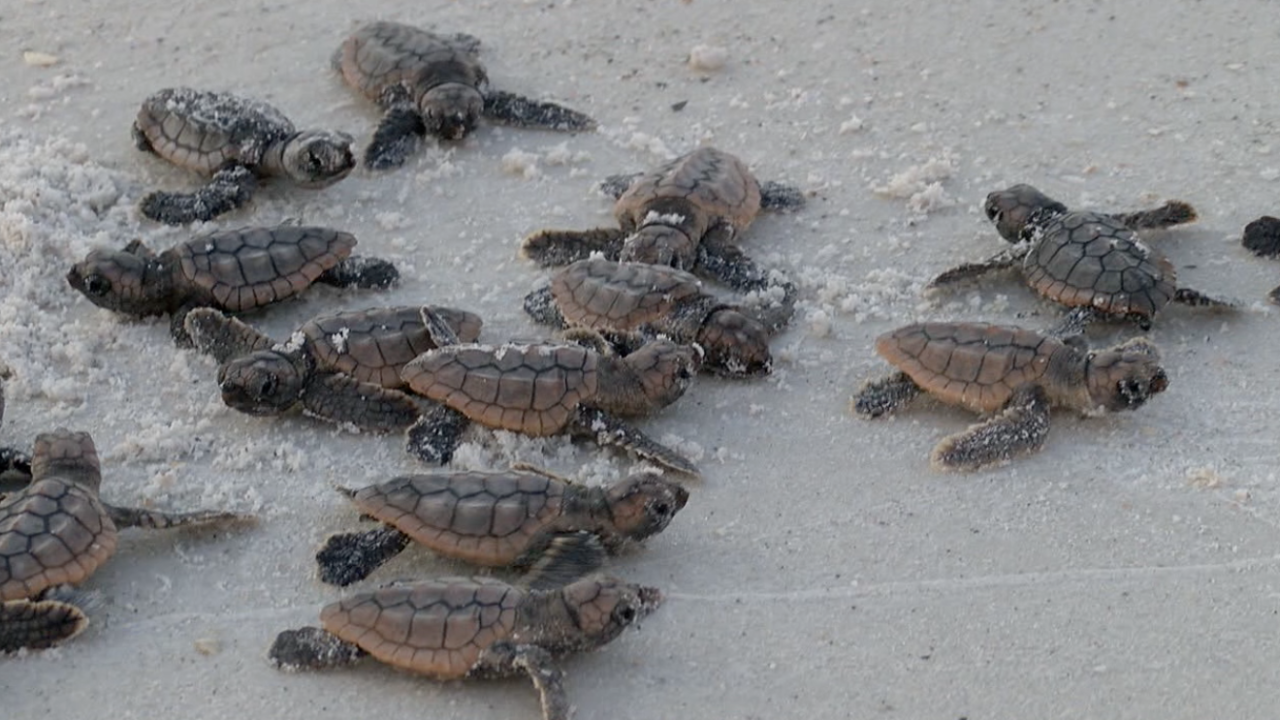While Tropical Storm Elsa damage did not impact a lot of people in the Tampa Bay area, it did disturb nearly 150 sea turtle nests on Pinellas County beaches.

By: Wendi Lane
Posted at 6:16 PM, Jul 08, 2021
and last updated 4:41 PM, Jul 08, 2021
CLEARWATER, Fla. — While Tropical Storm Elsa damage did not impact a lot of people in the Tampa Bay area, it did disturb nearly 150 sea turtle nests on Pinellas County beaches.
Clearwater Marine Aquarium says nearly 75% of the 200 sea turtle nests on Pinellas County beaches were impacted by storm surge.
Now teams of volunteers that work with CMA and monitor turtle nests along 20 miles of Pinellas coastline, are working to redo the work they’ve already done this season. This means locating the nests, replacing markers, and putting up signs.
"Unfortunately, the biggest threat to these nests is water. Who would’ve thought, right? They live in the water. But it's actually detrimental to the animals that live in these nests, the little baby sea turtles," said Kelly Martin, director of animal care for CMA.
Martin says it will take us a few days to “clear” the beaches for public access. Which typically includes a delay in placing any hotel cabanas, furniture, and beach cleaning that may occur.
If you see a sea turtle, nest, or hatchling in distress, Martin says do not touch or interfere with the animal, instead call the aquarium's hotline at 727-441-1790 ext. 1.
UCF study finds smaller turtles are nesting on Florida beaches
The findings give clues to the health and status of the threatened species
ORLANDO, July 8, 2021 - A new University of Central Florida study indicates that smaller loggerhead and green sea turtles are nesting on Florida beaches than in the past; however, researchers aren't sure why.
The findings, published this month in the journal Ecosphere, give clues to the status of the turtles, which is important to researchers who are monitoring the population health of the threatened species.
Central Florida's Atlantic coastline hosts about one-third of all green turtle nests in the state and is one of the most important nesting areas in the world for loggerheads.
Sea turtles are important as iconic symbols of conservation in Florida and for the role they play in maintaining a healthy ocean ecosystem.
The reason for the appearance of smaller nesting turtles is still a mystery though, says Katrina Phillips, the study's lead author and a doctoral candidate in UCF's Department of Biology.
"It might be that juvenile turtles are growing more slowly because they are having a harder time finding food as a result of habitat degradation or competition from other turtles," Phillips says. "Or smaller turtles may also be new recruits to the population as a result of successful sea turtle conservation efforts. We don't know why we're seeing more small turtles nesting."
The researchers made the discovery by comparing shell length of nearly 10,000 nesting female loggerheads and more than 3,000 nesting female green turtles. The measurements were collected by UCF's Marine Turtle Research Group over the course of a 37-year period, from 1982 to 2019.
The nesting turtles were observed in the Brevard County portion of the Archie Carr National Wildlife Refuge. Age is not recorded or known because it requires examining a cross-section of the turtle's leg bone, which would require invasively sampling the turtle, and even then, at best, age would be estimated.
The researchers found that the average size of nesting loggerheads decreased by nearly 1 inch and the average size of nesting green sea turtles decreased by more than 1.5 inches since 1982.
In addition to raising questions about why the turtles are smaller, the findings also mean that when estimating female sea turtle maturity based on size, researchers and management agencies will need to consider smaller turtles in their estimates.
"The numbers we provide for the minimum size range of mature females will help other groups who study turtles in the water, where it's not clear if they are mature or not, better estimate which of theirs are juveniles," she says.
The extensive study was made possible by the long-time work of UCF's Marine Sea Turtle Research Group, the researcher says.
"Many nesting beach projects take these measurements, but the UCF project is unique because of how long it's been going on and how many turtles come ashore to nest here," Phillips says. "Florida gets more loggerhead nests than anywhere else in the world, and the green turtle nest numbers are rising."
The monitoring project was started in 1982 by UCF Professor Emeritus and Pegasus Professor of Biology Llewellyn "Doc" Ehrhart.
Phillips says the UCF Marine Turtle Research Group will continue monitoring the nesting sites, which will allow researchers to assess if the trends continue or change.
###
Study co-authors were Gustavo D. Stahelin, a doctoral candidate in UCF's Department of Biology; Ryan M. Chabot, a graduate of UCF's master's in biology and bachelor's in environmental studies programs; and Katherine L. Mansfield, UCF's Davis-Shine Endowed Professor in Conservation Biology and director of UCF's Marine Turtle Research Group.
CONTACT: Robert H. Wells, Office of Research, robert.wells@ucf.edu
No comments:
Post a Comment